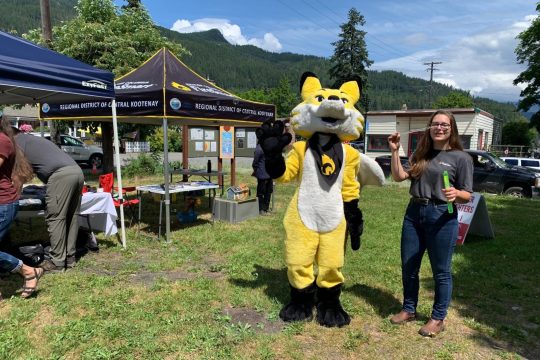The threat of wildfires is real and present in the Basin, and the City of Fernie is very aware of its vulnerability—the entire community was destroyed by wildfire on August 1, 1908.
Ted Ruiter, Fernie’s Director of Fire and Emergency Services, also known as the Fire Chief, says Fernie has been lucky to have the assistance of Alan Westhaver, a renowned FireSmart expert, who helped formulate its plan for wildfire risk reduction.
“Al happens to live in Fernie,” Ruiter says. “A number of years ago he suggested we look at the FireSmart Canada program and apply for grant funding from the Union of BC Municipalities. We received $10,000 from it and that was a good start.”
They then applied for funding available through the Trust’s Community Development Program, specifically for wildfire mitigation. As one way of helping the region adapt to climate change, these grants were intended to help local governments and First Nations communities educate residents about reducing wildfire risks, manage wildfire fuels, protect critical community infrastructure and develop emergency response and evacuation plans.
With this in mind, Ruiter and Westhaver sent in applications for projects that addressed the most pressing issues, hoping to immediately improve the community’s safety and achieve long-term public awareness and active support for fire safety.
Calling all citizens
The City of Fernie received $54,500 in funding for five projects that involve combined elements of wildfire fuel management, structural protection, emergency and evacuation planning, and public education.
A big part of reducing wildfire risks to residents and the community as a whole involves reducing wildfire fuels on residents’ properties. That’s why public support, in the form of participation in forest fire fuel removal and other FireSmart practices, is key to these projects’ success.
“Part of the challenge has been to change the local mindset to focus on what’s to be gained by preparedness rather than what might be lost in terms of aesthetics and recreation,” Ruiter says.
These projects will let people see first-hand how FireSmart practices will safeguard these elements. As well as being of immediate benefit, the investment of labour from the community will heighten awareness and encourage residents to become monitors and stewards who keep the area fire-safe into the future.
A range of projects
The first project is creating a Municipal FireSmart Demonstration Forest—a living example of how Fernie residents and land developers can apply FireSmart guidelines to their properties. Under the supervision of the Fernie Fire Department, volunteers are working to remove dead wood from the forest floor and selectively remove some of the trees.
Disposing of the woody debris—from the demonstration forest and other properties where similar removal is taking place—is the focus of the second project. This includes about a dozen events in which residents remove built-up vegetation and fuel hazards from their properties, which they haul to the curbside for free chipping.
The City also worked to assess and protect its critical infrastructure. In the event of a wildfire, this will help to preserve hospital service, wastewater treatment, communications hubs and an emergency operations centre, among other essential services.
The last two projects involved creating a long-term plan for continued thinning of forest fire fuels in the area immediately surrounding Fernie, and updating bylaws to help developers and builders create FireSmart properties.
Ideally, once the foundational work has been done in Fernie, other communities will refer to it as a model to inspire and guide their own FireSmart efforts.
“Climate change is everybody’s dilemma,” says Ruiter, citing a reason why the frequency and severity of wildfires are anticipated to increase in the future. “It’s vital that we move forward with the work right now.”












